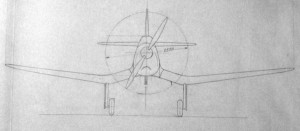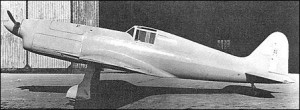 As WWII was approaching, Denmark’s air defences were based on outdated biplanes like the Hawker Nimrod. Despite of the Labour government cutting funding to the military, there were some developments. First and foremost, Denmark bought the rights from Fokker, to build the G1 Twin-Boom fuselage heavy fighter. Orders were also about to be signed for the Macchi M.200 fighter. The Danish government also showed interest in the Heinkel He-114, but that didn’t work out, for obvious reasons. Licenses had, however, been acquired for production of the Fairey p. 4/34, as well as the Fokker D.XXI. Both were under construction when the Germans invaded.
As WWII was approaching, Denmark’s air defences were based on outdated biplanes like the Hawker Nimrod. Despite of the Labour government cutting funding to the military, there were some developments. First and foremost, Denmark bought the rights from Fokker, to build the G1 Twin-Boom fuselage heavy fighter. Orders were also about to be signed for the Macchi M.200 fighter. The Danish government also showed interest in the Heinkel He-114, but that didn’t work out, for obvious reasons. Licenses had, however, been acquired for production of the Fairey p. 4/34, as well as the Fokker D.XXI. Both were under construction when the Germans invaded.
People at Orlogsværftet (Naval Dockyard) had, in all secrecy, started the design of an indigenous all-metal monocoque fighter aircraft named the J.1 Jager. The initiative came too late, and the J.1 Jager aircraft was never built. After extensive research, I have found additional information about the J.1 Jager, including some construction drawings.
It turns out that there were in fact TWO indigenous aircraft being designed, when the Germans invaded Denmark. Both aircraft had the same spitfire-like fuselage, but with two different wing configurations. The first configuration was pretty standard for a fighter aircraft of its time. The other wing configuration was a gull-wing arrangement similar to the one used on the Stuka. With that configuration, the aircraft would have been ideal for a light (dive) bomber. It is interesting to see that the designers had both type of aircraft in mind, but due to time pressures decided to go for a common fuselage.
 The J1 Jager aircraft would have had an all-metal monocoque fuselage very similar to that of a spitfire, but with a very long deHavilland-like motor cowl. The aircraft would have had retractable landing gear and a nice smooth aerodynamic shape – a real fighter. Nothing is said about the engine, but the outline drawn unmistakably looks like a Rolls Royce Merlin. With a proposed wing-span of only 8.75 m, or about 75% the size of the Spitfire, this would have been a really small, and nimble aircraft. In fact, it might just have been the aircraft with the highest power/weight ratio of all the aircraft available at the start of the war. Obviously at this early stage of the design, details like exhaust stacks and air coolers were not known. With a big-ass exhaust stacks on each side of the cowl and a belly-mounted cooling radiator, this aircraft would have really looked the part.
The J1 Jager aircraft would have had an all-metal monocoque fuselage very similar to that of a spitfire, but with a very long deHavilland-like motor cowl. The aircraft would have had retractable landing gear and a nice smooth aerodynamic shape – a real fighter. Nothing is said about the engine, but the outline drawn unmistakably looks like a Rolls Royce Merlin. With a proposed wing-span of only 8.75 m, or about 75% the size of the Spitfire, this would have been a really small, and nimble aircraft. In fact, it might just have been the aircraft with the highest power/weight ratio of all the aircraft available at the start of the war. Obviously at this early stage of the design, details like exhaust stacks and air coolers were not known. With a big-ass exhaust stacks on each side of the cowl and a belly-mounted cooling radiator, this aircraft would have really looked the part.
Specifications – J1 Fighter configuration:
Crew: 1
Wing-span: 8.75 m
Length: 7.76 m
Engine: (Outline looks like water-cooled V-12 engine)
Cruise Speed: –
Max Speed: –
Empty Weight: –
Armament: 4 x wing-mounted Madsen machine guns.
Specifications – J1 Bomber configuration:
Crew: 1
Wing-span: 8.75 m
Length: 7.76 m
Engine: –
Cruise Speed: –
Max Speed: –
Empty Weight: –
Armament: 4 x wing-mounted Madsen machine guns, 1 x bomb of unknown size.
I am presently designing a 1:5 remote-controlled model of the J.1 Jager. You can see the build-process here.
 The following photo is of the S.A.I. Ambrosini S.107 fighter, which gives an idea of what the J.1. Jager might have looked like.
The following photo is of the S.A.I. Ambrosini S.107 fighter, which gives an idea of what the J.1. Jager might have looked like.





 02/06/2011
02/06/2011
Thanks for the interesting J1 fighter article.
It is amasing how closely the J1 resembles the Italian SAI Ambrosini 107 and its SAI 207 light fighter variant (built in wood however).
The SAI was powered by a 750 hp Isotta-Fraschini engine and with the J1 being even a bit smaller in size than the SAI 207, I do not believe it would have had a larger engine like the Merlin.
Best regards
Jimmy
P.S: Also the nose shape clearly indicates that the engine is an inverted-Vee engine, which the Merlin is not.
Hi Jimmy,
The story of the J1 fighter is indeed very interesting, and you are of course right, the cowl indicates an inverted Vee engine.
Hello,
I understand you are building a 1:5 model of the J.1.
Do you have a plan view showing the wings from above (or below)?
I build models in 1:72 and would be interested in doing one of the fine J.1
Thank and best regards
Jimmy Waehrens